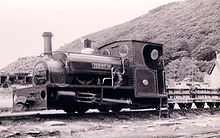
A traction engine is a steam-powered tractor used to move heavy loads on roads, plough ground or to provide power at a chosen location. The name derives from the Latin tractus, meaning 'drawn', since the prime function of any traction engine is to draw a load behind it. They are sometimes called road locomotives to distinguish them from railway locomotives – that is, steam engines that run on rails.

The Hunslet Engine Company is a locomotive-building company, founded in 1864 in Hunslet, England. It manufactured steam locomotives for over 100 years and currently manufactures diesel shunting locomotives. The company is part of Ed Murray & Sons.

The Bredgar and Wormshill Light Railway (BWLR) is located near the villages of Wormshill and Bredgar in Kent, just south of Sittingbourne. It is a 2 ft narrow gauge railway about three-quarters mile (1.2 km) in length.
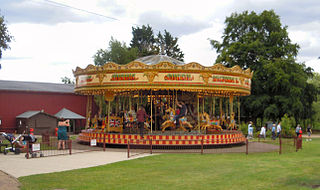
Bressingham Steam & Gardens is a steam museum and gardens located at Bressingham, west of Diss in Norfolk, England. The site has several narrow gauge rail lines and a number of types of steam engines and vehicles in its collection and is also the home of a Dad's Army exhibition.

Live steam is steam under pressure, obtained by heating water in a boiler. The steam is used to operate stationary or moving equipment.

A backyard railroad is a privately owned, outdoor railroad, most often in miniature, but large enough for one or several persons to ride on. The rail gauge can be anything from 2+1⁄2 in to 7+1⁄2 in or more. Smaller backyard or outdoor railroads that cannot be ridden are called garden railroads. Some backyard railroads use full-size rolling stock, such as the former 3 ft narrow gauge Grizzly Flats Railroad owned by railfan and Disney animator Ward Kimball.

Perrygrove Railway is a heritage railway of 15 in gauge. It is located at Perrygrove Farm in the Forest of Dean, near Coleford, Gloucestershire, England. Trains travel at frequent intervals on a round trip of 1+1⁄2 miles (2.4 km) between four stations. Passengers can ride on the train to use activities including a Treetop Adventure, a covered picnic and play area at Foxy Hollow, an Indoor Village with secret passages, and a den-building area in the woods.

Minimum-gauge railways have a gauge of most commonly 15 in, 400 mm, 16 in, 18 in, 19 in, 500 mm or 20 in. The notion of minimum-gauge railways was originally developed by estate railways and the French company of Decauville for light railways, trench railways, mining, and farming applications.

The Great Whipsnade Railway, also known as The Jumbo Express, is an English, 2 ft 6 in narrow gauge heritage railway that operates within ZSL Whipsnade Zoo in Bedfordshire, England.
The Rough and Tumble Engineers Historical Association puts on the second- or third-oldest Threshermen’s Reunion in the United States. It is held in the middle of August each year, from Wednesday through Saturday, in Kinzers, Pennsylvania, about eight miles east of the city of Lancaster. The association’s name is taken from the 1890s book Rough and Tumble Engineering: Book of Instructions for Operators of Farm and Traction Engines by James H. Maggard.
The Metropolitan Water Board Railway was a 2 ft narrow gauge industrial railway built to serve the Metropolitan Water Board's pumping station at Kempton Park near London. The line was opened in 1916 and closed shortly after the Second World War. A short part is operating once again to give rides to the public, under a new name, the Kempton Steam Railway
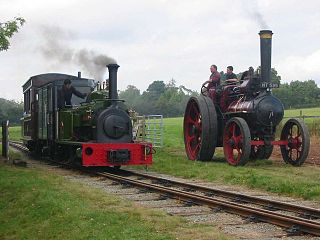
The Statfold Barn Railway is a narrow gauge railway based near Tamworth, Staffordshire and partially in Warwickshire, England. Founded by engineering entrepreneur Graham Lee and his wife Carol at their farm-based home, they originally designed what is still termed the garden railway, in which Graham could run his trains and Carol could design an extensive English country garden around a lake.
The Strumpshaw Hall Steam Museum in Strumpshaw, Norfolk is home to a collection of Traction engines, Steam rollers, a Showman's engine and a Steam wagon which are run on special occasions and on the last Sunday of each month from April to October.
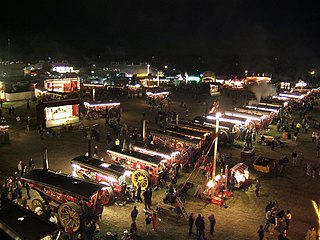
A showman's road locomotive or showman's engine is a steam-powered road-going 'locomotive' designed to provide power and transport for a travelling funfair or circus. Similar to other road-going traction engines, showman's engines were normally distinguished by the addition of a full-length canopy, a dynamo mounted in front of the chimney, and brightly coloured paintwork with ornate decorations. The dynamo was used to generate electricity to illuminate and power various fairground rides. Although originally the ride's motion was powered by an internal steam engine, some later rides were driven direct from the showman's engine via a belt drive.
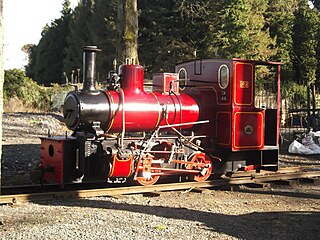
The Irish Steam Preservation Society is a voluntary organisation based in Stradbally, Co Laois whose aim is to preserve and maintain machinery connected to Ireland's industrial and social heritage. The society is responsible for the Irish National Steam Rally. Additionally, it curates the Stradbally Steam Museum and runs the traditional Irish 3 ft narrow gauge Stradbally Woodland Railway.
Hesston Steam Museum is an outdoor museum operated by the Laporte County Historical Steam Society in Hesston, Indiana. The museum occupies 155 acres and is the home of four different gauge railroads along with numerous other pieces of steam powered and vintage farm equipment.

The Miniature Railway Company on Broadway in Manhattan, New York, operated their ridable miniature railways at four World Expositions around 1900 and delivered them to many parks throughout the world.

Royden Park is a park in Frankby, Wirral, England, managed by Wirral Council. The grounds of the park were originally part of an estate owned by Ernest Royden which comprised the park, Hill Bark house and Thurstaston Common. Upon his death the estate passed to Hoylake council and was opened to the public for recreation. The park features a visitor centre, walled garden, miniature railway, woodland walks and a lake.


